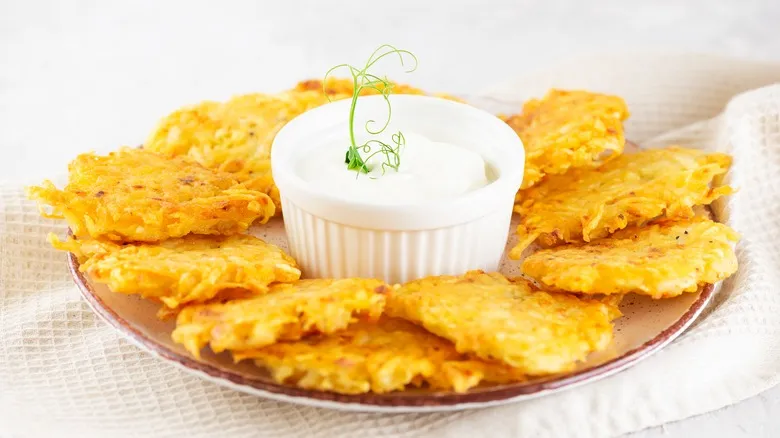What are latkes?

Many people have a fondness for potatoes and don’t require convincing of their value. The same goes for onions, which transform into a wonderfully sweet and juicy treat when cooked quickly at high heat. And when it comes to fried foods, well, that speaks for itself – they’re fried, and they’re a universal delight (at least for this writer). If you resonate with these sentiments, then latkes are a must-have in your culinary repertoire. They offer the ideal blend of crispiness and juiciness, featuring delicate, lace-like exteriors and moist, aromatic interiors – but what exactly are they?
Latkes are a delightful fusion of potato pancakes and fritters. Essentially, they consist of shredded potatoes and onions, bound together with eggs and flour to create a thick, chunky batter, which is then fried in oil to achieve a crispy, golden finish. With a touch of seasoning, you end up with a soul-satisfying medley of salt, fat, and crunch that is simply unbeatable.
As mentioned, latkes are a traditional Hanukkah dish that originated in Eastern and Central Europe, but they are now celebrated during the holiday in various countries worldwide. While latkes are often associated with the festive season – and that’s certainly how most people are familiar with them – their simple ingredients make them a delightful treat that can be enjoyed throughout the year.
Historical significance of latkes
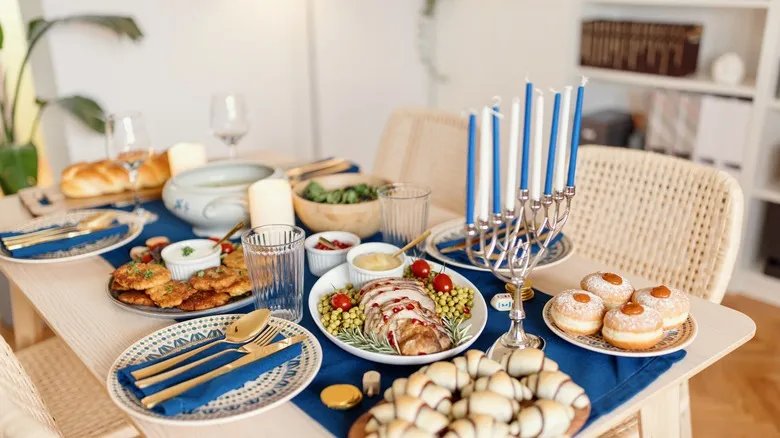
The Jewish community places great significance on food symbolism. A glance at a traditional seder plate reveals this: bitter herbs symbolize the anguish of slavery; charoset represents the mortar used in constructing Pharaoh's monuments; and a shank bone recalls the sacrifice made prior to the Exodus. While the historical accuracy of the Passover narrative may be debated, what stands out is the Jewish tradition of using food as metaphor, a practice that extends to Hanukkah as well.
In various cultures, certain foods are linked to the story of Judith, who beheaded the Assyrian General Holofernes to save her people. As she fed him salty cheese, some Jewish communities prepare cheese pancakes in her honor.
Hanukkah's narrative centers on the Maccabean Revolt, named after the Maccabees, a Jewish family that successfully rebelled against their Greek rulers. After reclaiming Jerusalem, they rededicated the Temple but found only enough oil for one night. Miraculously, it lasted for eight nights. To commemorate this miracle, Jews are encouraged to cook foods in oil.
Potatoes were not introduced to Eurasia until the 1600s, which explains why latkes are a relatively recent addition to the culinary tradition, although there were earlier versions made without potatoes. Alongside potatoes, onions and oil were affordable ingredients that helped celebrate the mythology of Hanukkah. The term "latke" is derived from the Slavic word for fried pancake, which in turn comes from the Greek word for olive oil.
Latkes versus potato pancakes and hashbrowns
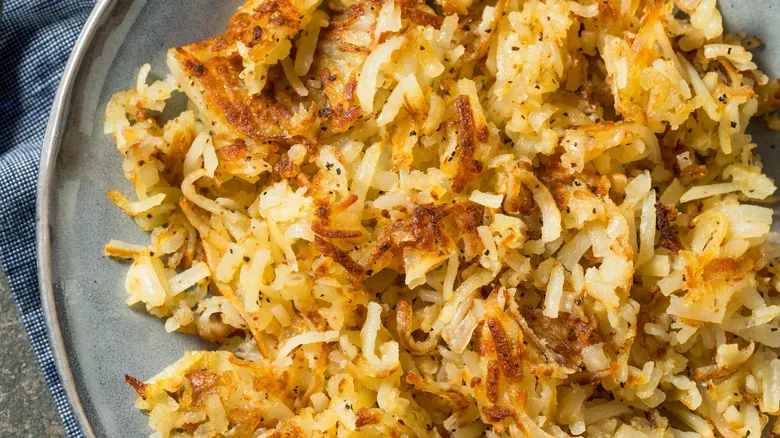
Before moving forward, it's important to address a common misunderstanding. At first glance, latkes may appear similar to hashbrowns, but they are quite different. Hashbrowns consist primarily of shredded potatoes, occasionally mixed with onion or onion powder, and are typically cooked in a single layer in a skillet. Some recipes use oil, while others opt for butter, but there is little tradition associated with them beyond the simple pleasure of indulging in fried potatoes for breakfast, which is always a treat.
Likewise, they may seem comparable to potato pancakes, but true to their name, potato pancakes are much more akin to pancakes, often incorporating mashed potatoes into the mix. Alternatively, some recipes instruct cooks to finely pulse potatoes until they resemble Kraft parmesan cheese. This method yields a very smooth batter that is softer and less crunchy. While tasty, these variations are not latkes either.
The basic ingredients of latkes

Nearly all latkes are made with a few essential ingredients: potatoes, onions, eggs, salt, and either flour or matzo meal, along with oil for frying. Russet potatoes are typically used because they grate easily, have a firm texture, and are simple to peel. They are also favored for their ability to become crispy on the outside while remaining soft on the inside, thanks to their high starch content—this is why they are commonly used for French fries. However, other types of potatoes, like waxy or sweet varieties, can be used, though they may be more challenging to work with.
Some recipes suggest frying latkes in schmaltz, which is rendered fat from poultry, such as chicken or goose. Most recipes, however, recommend using vegetable oil, with some advising the use of oils that have a high smoke point, like avocado, peanut, or grapeseed oil. If you want to enhance the flavor, you can mix a small amount of schmaltz with your cooking oil.
Finally, latkes need eggs and dry ingredients to hold the mixture together, along with salt for seasoning. Some recipes also include pepper, depending on personal preference. The dry ingredients can vary from flour to matzo meal, bread crumbs, or potato starch, or a combination of these, depending on the specific recipe. If you're new to making latkes, it's best to start with a traditional potato latke recipe.
Nontraditional latke ingredients
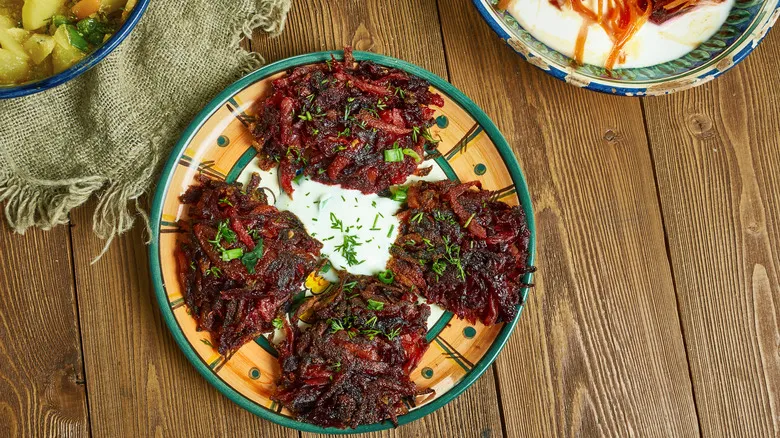
While the traditional Hanukkah latke is typically made with potatoes and onions, many classic recipes also incorporate zucchini and cheese. Therefore, it’s inaccurate to label these ingredients as nontraditional, allowing you the freedom to experiment with them while remaining connected to the dish's origins.
On the other hand, some ingredients are less tied to cultural traditions. For instance, if you want to explore beyond the classic latke, consider replacing potatoes with sweet potatoes. Sage and apple sweet potato latkes are a fantastic option if you're seeking a variation that requires minimal specialty ingredients and fits well into a fall menu. You can even add grated apples for a dessert-like twist.
Alternatively, you might experiment with waxy potatoes, which contain less moisture, or try a potato-free blend using cauliflower or beets. At this point, you’re venturing into fritter territory, and there are plenty of recipes for these variations available online. You can also incorporate seasonal ingredients into your latkes, such as pumpkin in the fall. Cheddar cheese is another popular addition that enhances the dish, making it a protein-rich vegetarian option for a weeknight meal.
Basic latke preparation
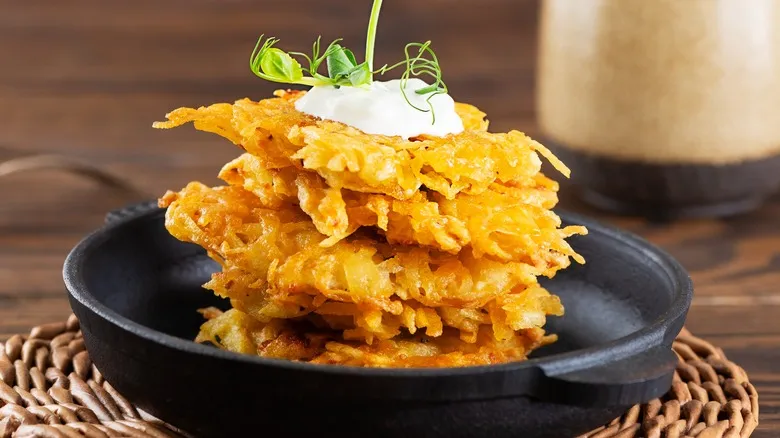
Latkes are prepared by grating potatoes and onions, then combining them with eggs, flour or matzo meal, and seasonings before frying in hot oil. To achieve delicious latkes, ensure your potatoes are thoroughly drained and your oil is sufficiently heated. It's also important to use the appropriate cookware, fry them for the right amount of time, and drain them properly once cooked.
Some recipes suggest soaking the potatoes while grating the onions, while others do not. Regardless, it's essential to drain the potatoes well by pressing them into a colander or, as I prefer, wrapping them in a dish towel and squeezing out the moisture. The goal is to have them nice and dry. After that, mix in the eggs, dry ingredients, and seasonings.
While preparing the mixture, heat your oil to about ¼ inch deep, enough to cover the bottom of the pan and rise halfway up the sides of the latkes. Once the oil is hot, drop a small amount of batter in to check for sizzling. It's time to fry the latkes by adding generous spoonfuls of the mixture to the pan and gently flattening them. Be cautious of splattering and avoid overcrowding the pan. Cook until golden brown on both sides, then drain on a grocery bag or paper towel.
For those with air fryers: you can also make latkes in your countertop convection oven, achieving a perfectly crispy texture without absorbing excess oil. A waffle maker can work well too!
How to keep latkes warm before serving
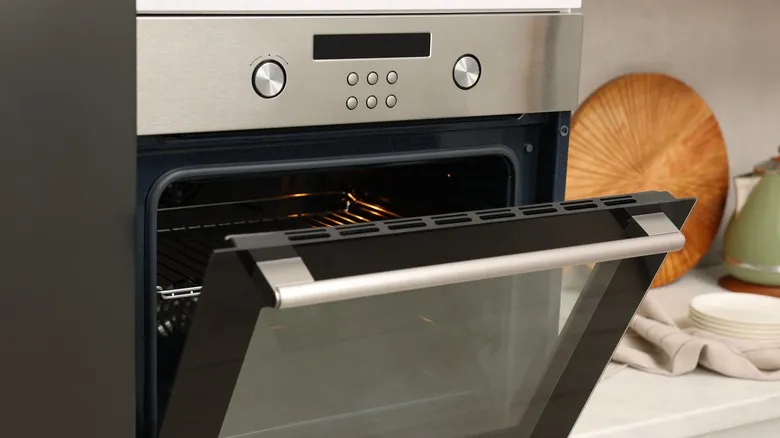
Latkes are traditionally associated with holidays and celebrations, which often leads to preparing them in large quantities. However, the challenge lies in the fact that they need to be fried in small batches, creating a dilemma for cooks. (Think of dishes like eggs Benedict and crêpes.) Ideally, latkes should be served right after frying, but that’s not always feasible. Don’t worry, though; there’s a solution.
To keep latkes crispy while waiting to serve, it’s important to avoid letting them sit on paper towels or grocery bags for too long after frying, as this can make them soggy. Instead, place them on a rack to allow air to circulate underneath, preventing moisture buildup. Keeping them in a 200-degree Fahrenheit oven is effective for maintaining warmth and crunchiness without drying them out.
What to serve latkes with for Hannukah
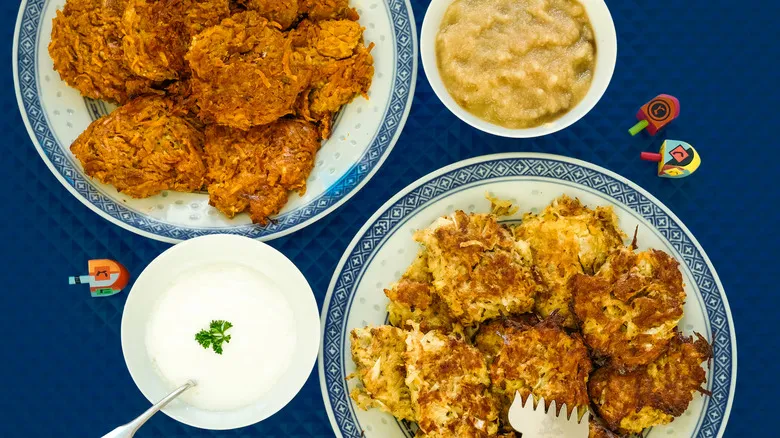
If you're preparing latkes for a classic Hanukkah dinner, there are a few essential condiments to include. First up is sour cream. Opt for the full-fat variety, as there's no reason to settle for watery or carrageenan-filled alternatives. You want a thick, creamy sour cream that holds its shape even on a hot latke.
Next is applesauce, which is more of a personal preference. Some prefer it smooth, while others like it chunky; some enjoy it sweet, while others prefer it less so. Homemade is always the best option. Simply peel, core, and chop some apples, then cook them on the stove with a bit of water, sugar, cinnamon, and lemon juice (the last three are optional, but water is necessary). Let it simmer over medium heat, then mash it all together. If making it from scratch isn’t feasible, store-bought is acceptable. Just be sure to check that your jarred applesauce is thick enough, as watery varieties will quickly make your latkes soggy.
Serve both the sour cream and applesauce in bowls that can be easily passed around. Resist the urge to prepare and garnish them in advance, as this can lead to sogginess, and guests typically prefer to add their own portions.
Other foods to accompany latkes at Hannukah
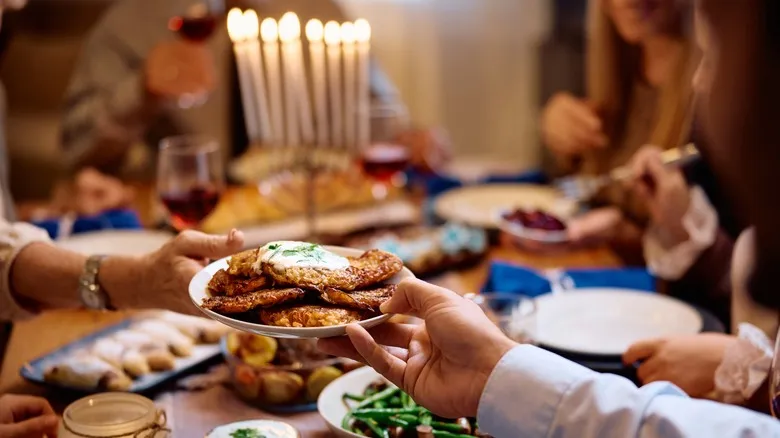
Each family has its own unique way of celebrating Hanukkah (and we’ve even been known to indulge in ham, the quintessential lax Jew dish). Nevertheless, there are some traditional Hanukkah foods that pair wonderfully with latkes. If you're planning a classic meal for the Festival of Lights, consider including a few of these dishes alongside your latkes.
Roast chicken is a standout option. It's incredibly simple to prepare, so if you haven't already mastered a good roast chicken, now is the time to do so. Plus, it can cook quietly in the oven while you focus on making your latkes. Just remember to take it out and lower the oven temperature before you start frying, so you can keep the latkes warm when they come out of the pan. While beef was rarely served in my household growing up, brisket is another popular pairing with latkes.
Kugel, challah, and matzo ball soup are also favored choices. For vegetables, a simple salad or steamed veggies work well. And for dessert, rugelach are delightful, but I personally prefer sufganiyot, traditional jam-filled donuts similar to beignets. Although they require quite a bit of effort to make, the end result is definitely worth it—just be prepared for some splatter during frying!
Latke serving variations
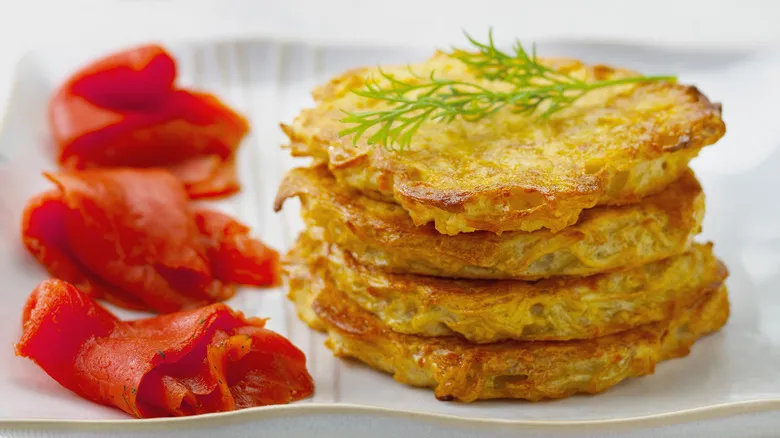
Latkes are traditionally linked to the story of Hanukkah, but there's no reason to limit their enjoyment to the winter holidays. With a plethora of latke variations available, you can savor them throughout the year with a variety of toppings. You can opt for heartier potato pancakes that are rich in flour or matzo meal, or go for lighter fritters that primarily feature potatoes and onions—my personal favorite.
In fact, latkes are quite similar to potato pancakes or Russian blini that you might pair with lox and sour cream. They can be adapted to incorporate different culinary influences. Consider adding feta and spinach for a Greek twist, curry for an Indian flair, or beets for a Russian touch. How about using latkes as the base for eggs Benedict instead of English muffins? Absolutely! You can also blend in some goat cheese and top them with chives for an elegant spring or summer dish. The possibilities are truly endless.
Sourcing latke ingredients
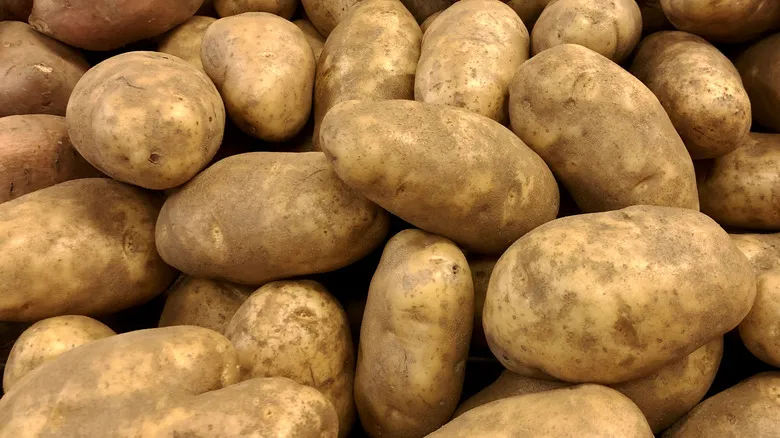
Latkes rely on just a handful of ingredients, so it's important to choose quality ones. Fortunately, these ingredients are neither costly nor hard to find. Be sure to select firm russet potatoes and sweet onions. If you decide to experiment with waxy potatoes, it's wise to master your basic latke recipe first, as they cook differently.
Whenever possible, opt for fresh eggs when making latkes. You can identify an older egg by its clear white, which should ideally be cloudy. Over time, the egg white becomes more watery, indicating staleness, although it remains safe to use unless it appears pink or iridescent. When you crack the egg on the counter, it should not spread too much, indicating a thick consistency that will help bind your batter.
As for flour, any type will work, but be aware that whole wheat and other unconventional flours may result in denser latkes. If you're using matzo meal, there's no need to splurge; Manischewitz will do just fine. For oil, stick to what your recipe specifies, but be sure to smell it first to ensure it’s not rancid, as that could affect the flavor of your latkes.
Where to find latkes already made

Unfortunately, there aren't many places to find ready-made latkes. However, you can typically find them at a Jewish deli. Keep an eye out for them while searching for Reuben sandwiches or exploring some of America's iconic delis. For example, Zaftig's offers delicious loaded latkes; the name "zaftig" in Yiddish means "plump," which is a good sign of their quality.
You can also check out Guy Fieri's "Diners, Drive-Ins and Dives" for other tasty Jewish food spots, like Perly's in Richmond, Virginia, where they serve potato latkes. If you're not up for making them yourself and are in the area, it’s definitely worth a stop. If you find yourself in New York City, Katz's is always a solid option. Alternatively, you can simply search online for "latkes + [your area]" to discover a restaurant or two nearby.
If you're interested in making latkes at home but want to keep it simple, you can find them in the frozen food aisle or as a boxed mix. Trader Joe's, for instance, offers two varieties: a classic potato latke and a cheesy cauliflower option for those who are gluten-free, both of which can be easily heated in the oven. If you prefer a boxed mix, Manischewitz has you covered as well. Just add eggs and water, fry them up in oil, and you’ll have a delicious treat in no time.
Storing leftover latkes
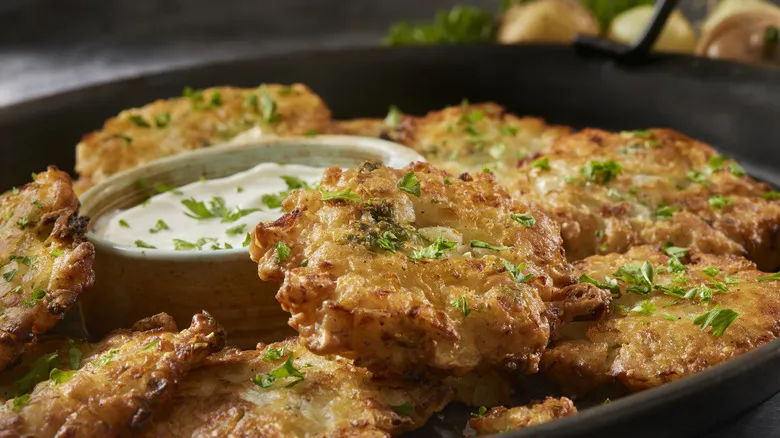
If you're clever, you'll prepare more latkes than necessary. Grating, draining, mixing, and frying them can be quite a hassle, so it's wise to make a large batch and save some for later. They reheat nicely, and you'll find the leftovers nearly as enjoyable as the fresh ones.
Before storing latkes, ensure they cool to room temperature. This helps avoid steam buildup that can lead to sogginess. You can keep leftover latkes in the refrigerator, ideally in a single layer within a flat container. If you prefer to stack them, place wax paper or paper towels between layers to make reheating easier. The same method works for freezing them.
For reheating, the oven or air fryer is your best bet, as they circulate dry air to restore that crispy texture. Avoid re-frying the latkes, as this will only make them tough and unappetizing, not to mention heavy on the stomach.
Nutritional information
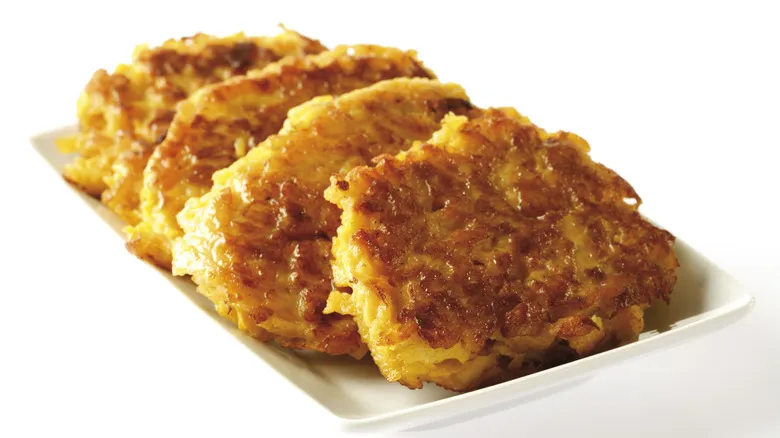
Let’s be honest: latkes aren’t exactly health food. While onions are beneficial and eggs have their rightful spot in the food pyramid, it’s tough to argue that potatoes and oil are super healthy. That said, this doesn’t mean you should avoid latkes altogether; they are a delightful treat, and let’s face it, few holiday dishes are low in calories. Enjoying latkes in moderation is perfectly fine, but it’s important to be mindful of their nutritional content.
The specific nutritional values of your latkes will vary based on the ingredients, the recipe, and the temperature of your frying oil. Hotter oil cooks latkes more quickly and absorbs less oil, so ensure your frying oil is at the right temperature before adding the batter. On average, a latke can contain anywhere from 100 to 215 calories per serving. If you’re concerned about the calorie count, you can usually find the nutritional information in most recipes.
Recommended
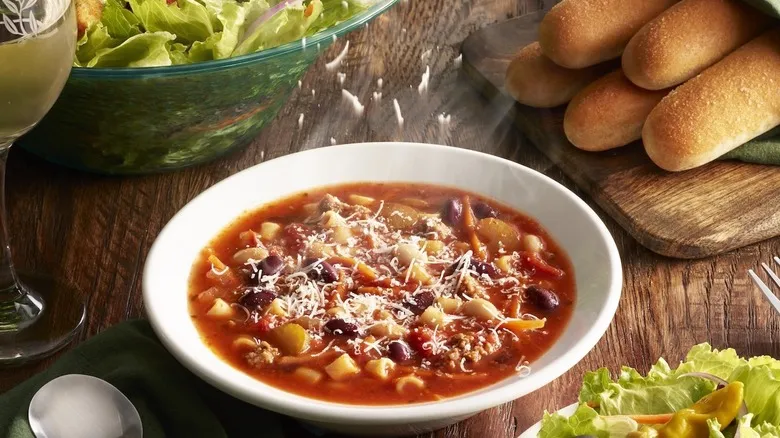
The Brand Behind The Olive Garden Cheese Grater
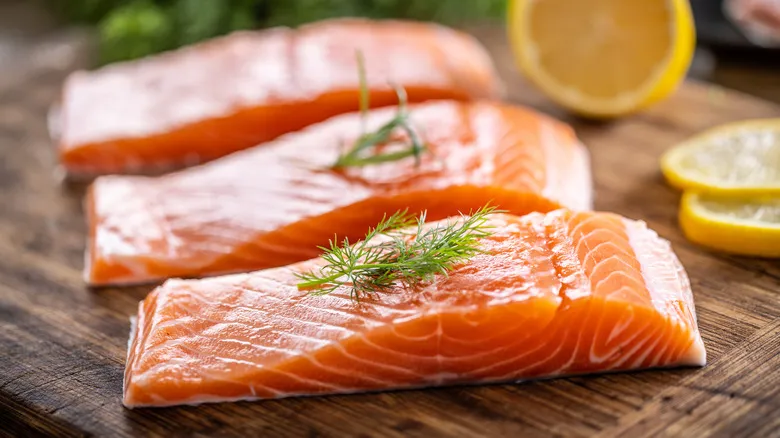
11 Genius Ways To Disguise Fishy Tastes In Seafood
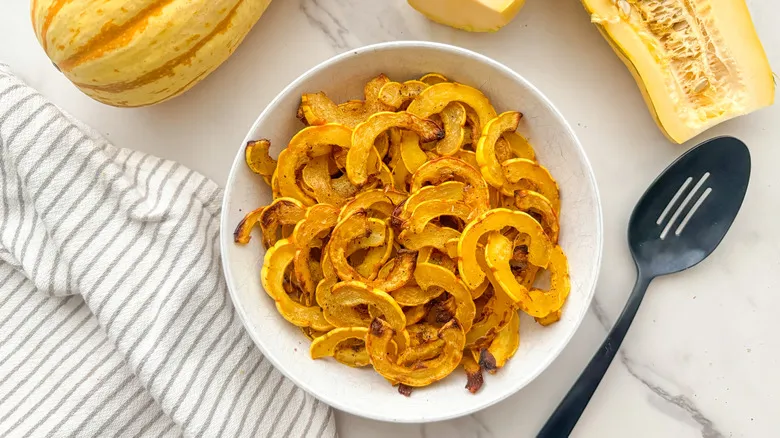
How To Cook Delicata Squash Like A Pro

How To Easily Turn A Stainless Steel Skillet Into Nonstick Pan
Next up

